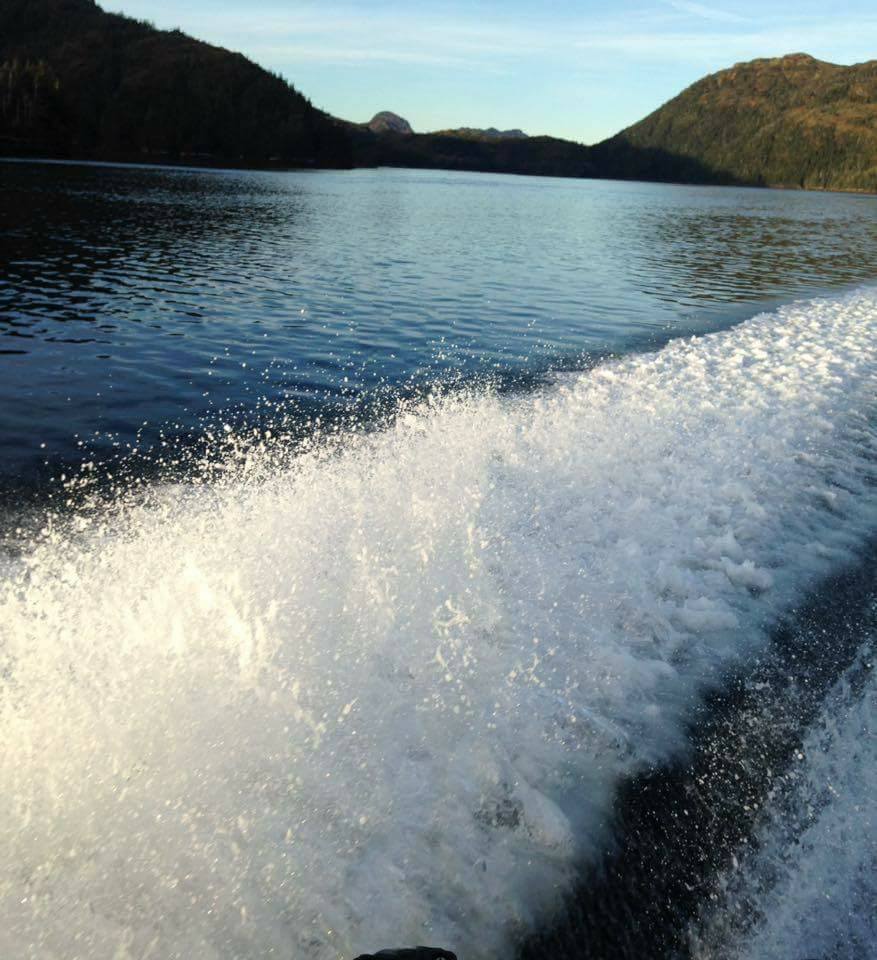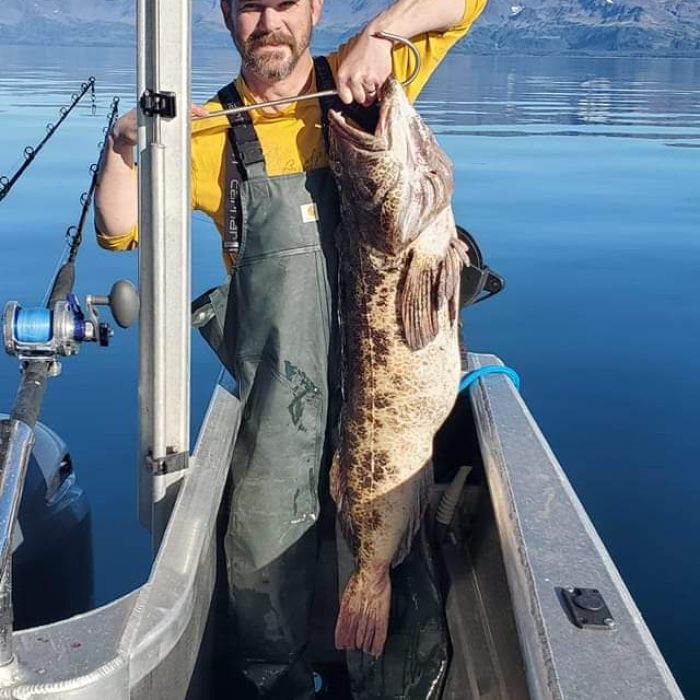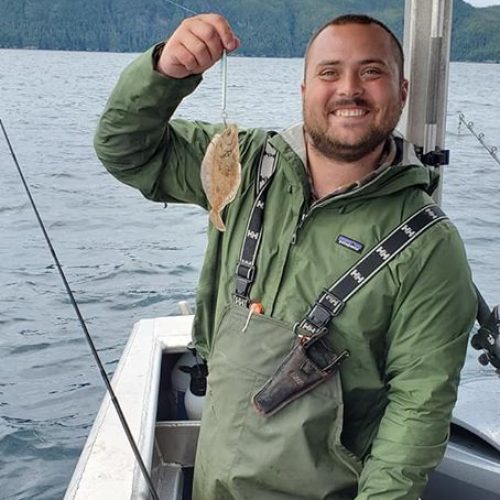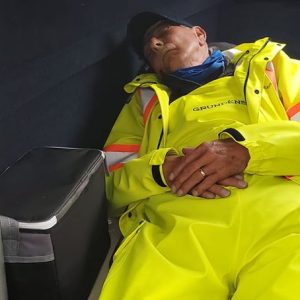Fishing; the
day. ride. boat. catch. fish. reward.
- On the morning of your trip, you will travel through the Anton Anderson Memorial Tunnel at the 6:30 AM opening and head straight into Whittier. The tunnel operates for 15 minutes in each direction. If you’re late, you’ll have to wait an hour for the next opening.
- Call when you get through the tunnel and we will instruct you on where to meet us.
- We will then walk down to the loading ramp and board The Wildlife for the trip of a life time.
- You’ll leave the Whittier Harbor and turn east out of Passage Cannel, past Port Wells and head out for a day of fishing and sightseeing.
- The trip out will take about 2.5 hours to get to the fishing grounds.
- The captain will pick out what type of rig you’ll need, ether a jig or bait rig.
- As you let out your line you will notice that you can see your rig drop out of sight some 20 to 60 feet below. Hold on that’s not the bottom, there’s another 100 – 400 feet further. Prince William Sound is quite deep. There are places in the sound that are 400 + fathoms deep. For those of you that are trying to figure that out, its 6 feet to a fathom or 1.828 meters to a fathom. No matter how you figure it; that’s a long way down.
- Once you hit bottom, the skipper will then instruct or help you fine tune your fishing technique for the sound. Oh yes, don’t forget to keep an eye out for the wild life.
- Your trip back to Whittier will be a short one for most. That’s because most fall asleep after a hard day of fishing. You can kick back and enjoy the ride.
- Once at the dock; Jody will take your fish to the cleaning tables, lay them out on the dock and there you can take all the pictures you want.
- Now that all the fun has been had for the day, its time for the real work! Jody fillets your catch for you.
During your trip: remember that with some 3000 miles of shoreline, 2500 square miles of water, and over 70 islands you have a chance to see some of Alaska’s most beautiful shore lines and animals that live there. Be prepared to find Ball’s Porpoise, Harbor Seals, Stellar Sea Lions, Killer Whales and Humpback Whales, the always present Sea Otter and sea birds. You will also see land animals, from Black Bears to Sitka deer! If you are really lucky, you might even see a Brown bear on Montague Island.

The Ride out and fishing grounds...
"Are we there yet?" This is the typical question after the fisherman stares at his watch for the third time. Every boat is different, but in general, if you're going on a halibut trip out of Whittier, Valdez, or Seward, the chances are good that you're going to travel for a while to get to the fishing grounds. On my trips out of Whittier, we typically travel for two to two and a half hours at 30 knots to reach the grounds. I really wish we didn't have to travel so far (the fuel bills are a nightmare), but that's the way it is. In order for me to consistently expect to find good numbers of fish we need to travel that far. One of the nice things about Prince William Sound is that it's fairly protected. I spend most of my time fishing in really calm water. It does get rough occasionally though, and this is something you might want to consider. Yes, you could be in a boat, in less than still water, all day. This is especially true if you are in a boat that plans to fish in the open Gulf of Alaska. Generally in the gulf you can always expect some groundswell and this surging is usually what gives people that queasy feeling. If you do have a tendency to get sick, start your treatment (dramamine, etc.), the night before your trip.

Whole Boat Charters...
One of the worst common situations I face onboard is having mixed groups of people with different objectives. Mom, dad, and daughter are on the boat for their first fishing trip to have a good time and catch a few fish, while Frank, Bob, and Eddie are on their twentieth trip and want to travel halfway to Hawaii to slay the big ones. There certainly are times when this group can be happy together. Sometimes the best fishing to be found is in calm areas and everything is great. Other times, however, things aren't so perfect. When you introduce a variable such as moderate wind things change. Now I'm faced with either not putting Frank, Bob, and Eddie on the best possible spot, or I'm going to give Mom, dad, and daughter a little more of a nautical experience than they had hoped for. Obviously, the way to go, unless you're fairly durable and easy going, is to book the whole boat for your group. The trip can be much more enjoyable when the captain can customize a trip for the group.

The fishing...
Another good reason to book a boat as a group is that halibut fishing isn't always easy. Cranking up three or four pounds of lead from 200 feet down isn't everyone's idea of a good time. This isn't the norm, but there are times when that's the price to pay for nice fish. On The Wildlife we use 16oz jigs and fish between 30 - 450 ft with two speed reels. Contrary to what a lot of advertising would lead you to believe, fish don't always jump into the boat either. Yes, make no mistake, Alaska does still have some amazing fishing. There are times when big fish come up two or three at a time and the limit is caught by noon. This is not normal however. On most trips you can expect to work for nice fish. This is fishing and it does take patience. On many halibut trips we spend more of our time waiting than catching. Things do change fast though; it's not uncommon to catch nothing by noon and have the limit by 3:00. Nothing is more aggravating than a fisherman who gives up one hour into it because "there are no fish here". Persistence pays off. Try to find captains that don't sleep well if they're not catching fish and give them some faith.

Should I keep that Halibut?
Everyone wants to go home with two halibut. Here's another dilemma that seems to be getting worse as time goes on. The worst scenario for me is to drop down on a spot early in the day and have everyone hook into 20-25lb fish, these fish are the best eating size. Fishing is fishing however, and I've seen people throw back small fish all morning and wish they could buy them in the afternoon. I've also seen people keep smaller fish and then watch their friends catch much bigger fish later. If it were me, I would probably keep the chunkiest of the smaller fish and then hope for the best. There are alternatives too. If you don't mind keeping fish that are less than grand, you might be able to devote some time to chasing lingcod, rockfish, and/or salmon. There are really nice fish out there. That said, realistically, our waters are being fished pretty hard these days. The recreational fleet is growing and I've seen and have heard of more commercial longline boats fishing in the areas I fish lately. The days of throwing back anything under fifty pounds are gone, at least for now.

What do I do now?
You had a nice day and now you have a hundred pounds of fillets to bring home. This is a great situation, but you might want to consider the expense if you're planning on shipping that fish. Most ports have businesses nearby that will vacuum pack, freeze, and ship....but it isn't cheap. It's a shame not to vacuum pack fish that won't be eaten fresh. Most people bring a couple of coolers with them to hold iced fish for the trip back home. A plastic bag in the trunk of a rental car isn't going to work.